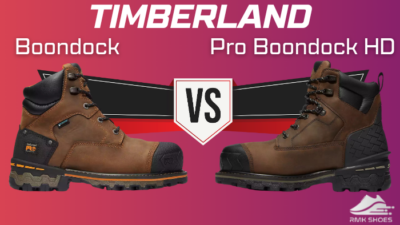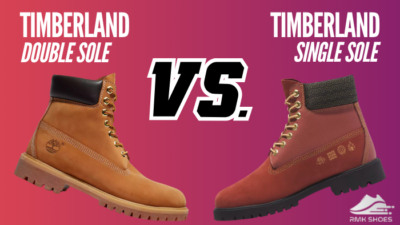In the runner’s odyssey, let’s lace up with the ASICS Cumulus and Evoride – two well-known performance footwear in the mid-tier price range.
With the Cumulus 25’s cushioned comfort embracing my feet, it quickly became a reliable companion for my everyday activities.
In contrast, the sleek and speed-focused design of the Evoride 3 delivered an exhilarating surge of acceleration, making it ideal for runners seeking a swift and dynamic ride.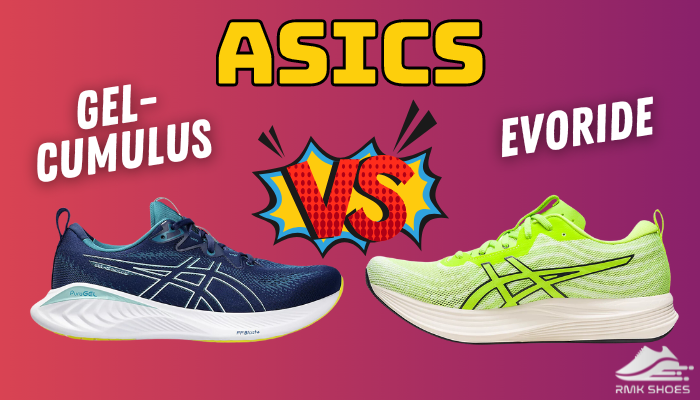
As a connoisseur of running gear, I invite you to join this exploration, comparing the nuanced symphony of the Cumulus 25 and the adrenaline-fueled sprint of the Evoride 3.
So, let’s start the comparison.
Overview of ASICS Evoride and Gel-Cumulus
ASICS Evoride and the Asics Gel Cumulus provide different types of runners and offer unique features that enhance the running experience.
This overview explores the traits of these running shoes, giving you insights into their design, performance, and suitability for running styles.
Asics Evoride
The ASICS Evoride running shoe offers a combination of affordability and speed, catering to individuals seeking a practical and energizing running experience. The Evoride 3, the latest model in this series, is priced at $120, which is a no-brainer.
Moreover, boasting a Guidesole and rocker design, this shoe is engineered for swift, smooth transitions. Ideal for tempo runs and faster paces, its sleek silhouette is complemented by a breathable mesh upper and a durable outsole.
Whether chasing speed records or enjoying a brisk run, the Evoride promises a responsive and dynamic running experience.
Asics Gel-Cumulus
For the seekers of plush comfort and enduring support, the Asics Gel Cumulus emerges as a vital companion in the daily training arena. The Gel Cumulus 25, priced at $140, is the latest testament to its legacy.
With gel units strategically placed in the heel and forefoot, it ensures shock absorption and a cushioned feel. This shoe is ideal for easy runs and heel strikes, with a breathable mesh top and a durable outsole.
The Cumulus, a reliable mid-priced daily trainer, boasts a 25-year legacy as Asics’ go-to neutral shoe. Also, It had some significant changes over the years.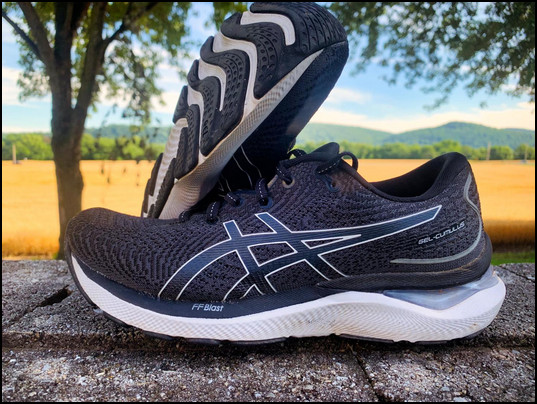
For example, if you check the Cumulus 22 and Cumulus 21, you will understand the gap and Asics’ commitment to the comfortable running shoe.
Now that we’ve explored the distinct offerings, let’s compare the Asics Evoride 3 and Asics Gel-Cumulus 25 features to help you choose the right running shoe.
Feature Comparison of Asics Evoride 3 and Gel-Cumulus 25
Exploring Asics’ array of running shoes, I am drawn to two standout options for neutral runners – the Evoride 3 and the Gel-Cumulus 25.
With both promising cushioning and support, they cater to distinct running styles and individual preferences.
Now, let’s dissect their critical features in the below side-by-side comparison table to guide you in making an informed choice:
| Feature | Asics Evoride 3 | Asics Gel Cumulus 25 |
|---|---|---|
| Weight (Men’s size 9) | 7.4 ounces | 9.3 ounces |
| Upper Material | Jacquard mesh upper | Engineered Jacquard Mesh |
| Insole | Solution Dye Sockliner, OrthoLite X-30 | OrthoLite X-30 sockliner |
| Midsole | FLYTEFOAM™, Curved sole for a smooth, rocking motion | FF BLAST™ PLUS, PureGEL, Flatter sole for a stable, traditional feel |
| Outsole | Durable rubber outsole with a rocker-style design for propulsion | AHAR (Asics High Abrasion Rubber) outsole for excellent durability |
| Cushioning Type | Responsive/balanced | Plush / Highly cushioned |
| Heel-to-Toe Drop | 5 mm | 8 mm |
| Tongue Design | Highly cushioned tongue | Gusseted and highly cushioned |
| Pronation Support | Neutral shoe suitable for runners with a natural gait | Neutral shoe with options for mild to moderate overpronation support |
| Flexibility | Medium | Flexible |
| Stability | Some stability | Very stable |
| Size | True to size | True to size |
| Price | $120 | $140 |
| Recommended Use | Speedwork, daily training, Tempo runs, marathons | Easy runs, recovery runs, long distances |
Unveiling these similarities and differences between the two shoes, it becomes apparent that although they both possess a mesh upper and a rubber outsole. However, there are notable variations in price, weight, heel drop, and the type and quantity of cushioning used.
These distinctions are pivotal in dictating performance and comfort, aligning with your unique running style and preferences.
In the following section, I’ll delve deeper into the primary differences, providing a nuanced understanding of each shoe’s essence.
Primary Differences between ASICS Gel-Cumulus 25 and EvoRide 3
Asics Gel Cumulus 25 and Evoride 3 are neutral running shoes. While the Cumulus 25 is a luxurious limousine for your feet, the Evoride 3 is a sleek sports pair for every stride.
Cumulus 25’s plush PureGEL cushioning pampers you on long runs while the stable, flat sole provides reassuring support. On the other hand, EvoRide 3’s lightweight FLYTEFOAM construction lets you fly, and the curved sole propels you forward effortlessly.
I have tried out these shoes in various scenarios and noticed some distinctions. I’ll now describe those differences to you.
Here are the differences between the Asics Gel-Cumulus 25 and EvoRide 3:
1. Target Pace
When considering target pace, the Asics Gel-Cumulus 25 excels in easy and long runs, offering a moderate and comfortable speed.
When I started running long distances with the Cumulus 25, it was my trusty companion for those slow and steady jog sessions.
But as I started craving a little more pep in my step for those weekday tempo sessions or shorter races, I gravitated towards the Evoride 3.
Its light and responsive ride, coupled with a rocker design, facilitates swift transitions.
I’ve found it perfect for interval sessions when pushing myself harder.
EvoRide also has the Speed model. It’s reputed to be faster than the EvoRide 3, ideal for speed enthusiasts seeking a more advanced option.
For the targeted pace, both shoes have different strong points. Pick the Cumulus 25 for a comfortable training session and Evoride for a speed run.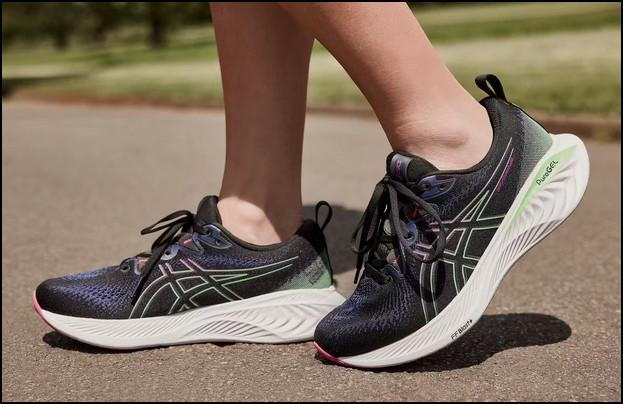
2. Cushioning and Comfort
Regarding cushioning and comfort, the Cumulus and EvoRide offer distinct experiences.
The Cumulus 25 is plush, with its PureGEL pods like soft clouds cradling your feet. Each step feels oh-so-gentle, perfect for long runs where fatigue shouldn’t be a concern.
I remember tackling a marathon in the Cumulus 25, and my feet felt pampered the whole way for the plush cushioning.
The EvoRide 3, on the other hand, strikes a balance between comfort and responsiveness.
Its FLYTEFOAM™ cushioning is still light and airy but with a bit more bounce. On tempo runs, the EvoRide felt like it had extra gear, urging me to pick up the pace without sacrificing comfort.
Of course, if you’re a speed demon craving a feather-light touch, the Evoride Speed will be a great option.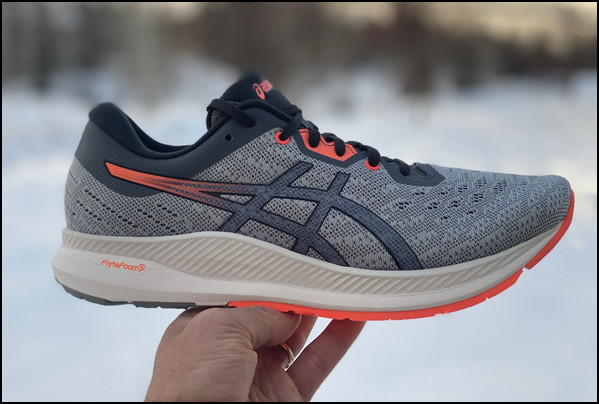
Also, most Asics shoes offer excellent heel counter and collar cushioning.
This is also the case for the Gel-Cumulus 25 and Evoride 3.
So, how about the tongue?
The Cumulus has an exceptionally plush and puffy tongue, providing superior comfort and a perfect fit. While The Evoride’s tongue is also comfortable, it lacks the same level of plushness and snuggly, which also helps to fulfill its speedy preferences.
Ultimately, Cumulus 25 is for pillowy comfort on long hauls, and EvoRide 3 is for a bouncy, supportive balance.
3. Upper Materials
Differentiating the upper materials of these two shoes without just the materials also comes down to breathability versus snugness.
The Cumulus 25 boasts a generously Engineered Jacquard Mesh, like a light, airy hammock for your feet. It’s perfect for those hot summer runs where ventilation is vital.
Meanwhile, the EvoRide 3 opts for a slightly more streamlined fit. Its jacquard mesh feels plush and luxurious, hugging your feet like a supportive second skin.
I loved the snug feel for tempo runs, mainly downhill sections where I craved extra control while it’s still breathable.
In my use of the 270 miles with the Cumulus 25 and Evodide 3, I find the upper of the Cumulus sturdy, breathable, and comfortable. Also, they incorporated recycled materials in their upper, which is durable.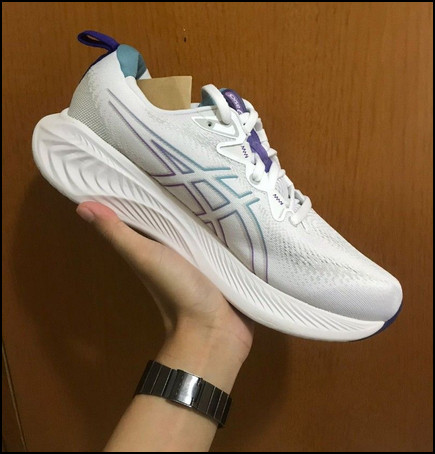
4. Overall Design
Both shoes might look the same, but you should immediately realize the distinct design differences when you put your foot in the shoe.
Toe Box
The Gel-Cumulus 25 embraces a wide and roomy toe box, allowing my toes to splay naturally – a feature I appreciate for its comfort and spacious feel. However, the EvoRide 3 opts for a narrow, snug toe box, providing a more closely fitted experience.
Vamp
Crafted from recycled materials, the Gel-Cumulus 25 showcases a substantial and plush design. In contrast, the EvoRide 3 incorporates recycled materials into its thin and lightweight upper.
The EvoRide 3’s upper has earned my preference for its superior breathability and foot support.
Lacing & Tongue
Both shoes utilize traditional lacing systems, albeit with slight variations. The Gel-Cumulus 25 incorporates flat laces, round eyelets, and a webbing-style design, while the EvoRide 3 employs round and reinforced eyelets.
Also, the Gel-Cumulus 25’s padded and gusseted tongue prevents unwanted sliding and offers superior cushioning for my foot. In comparison to the EvoRide 3’s thin and non-gusseted tongue, I prefer the tongue design of the Cumulus 25.
Heel Counter
Contrasting heel counter designs distinguish the two. The Gel-Cumulus 25 boasts a large, firm heel counter, providing stability and support.
In contrast, the EvoRide 3 adopts a small and flexible heel counter, offering enhanced freedom and comfort for the heel.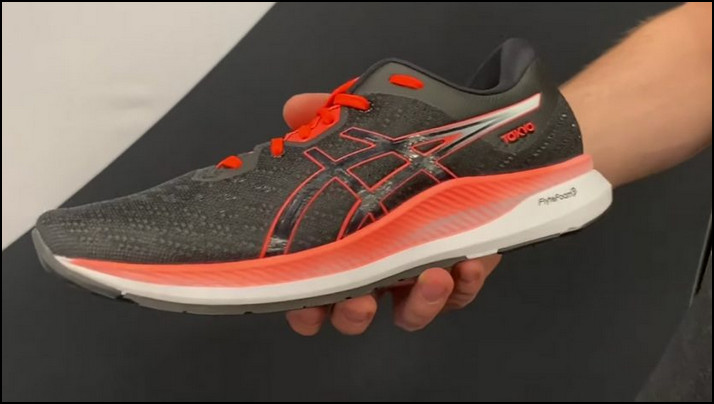
Collar
Moving to the collar, the Gel-Cumulus 25 features a high and thick collar, offering substantial ankle cushioning and protection.
Meanwhile, the EvoRide 3’s low and thin collar exposes and frees the ankle, providing a different, more liberating feel.
5. Sole Technology & Design
The Gel-Cumulus 25 utilizes a midsole with FF BLAST™ PLUS and PureGEL technologies. This combination offers a flatter sole, providing a stable and traditional feel during your runs.
On the other hand, EvoRide 3 features a midsole made of FLYTEFOAM™, which provides a lightweight and responsive feel.
Its curved sole design allows for a smooth and natural rocking motion, promoting a more efficient stride.
Regarding the outsole, the Cumulus 25 features an AHAR (Asics High Abrasion Rubber) outsole, which offers excellent durability for long-lasting use.
Meanwhile, the EvoRide 3 boasts a durable rubber outsole with a rocker-style design.
This design promotes propulsion and a smooth transition from heel to toe.
The soles are purposefully designed, but the overall feel is better in the Gel Cumulus 25. That might be due to comfort and enhanced stack height.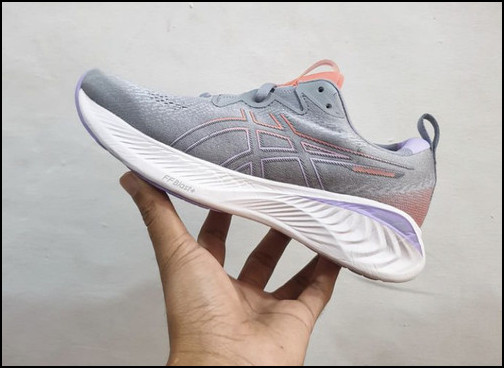
6. Performance Evaluation
Regarding performance, the Cumulus 25 and EvoRide 3 shine in different areas.
The Cumulus offers plush comfort and stable support for long distances, ensuring a comfortable and enjoyable running experience. While it may not break speed records, it excels in recovery runs and weekend adventures, providing pure comfort and bliss.
In contrast, the EvoRide 3 is a tempo titan. Its lighter design and snappy midsole encourage a quicker pace.
While still comfortable, it feels more energetic, urging you to pick up the beat. I found myself pushing my pace during interval sessions and feeling surprisingly sprightly on tempo runs with the EvoRide.
Both have distinct performances. Simply, if your purpose is training run and comfortability, pick the Gel-Cumulus 25, and for a speedy pace, choose the Asics Evoride 3 or Evoride Speed.
7. Stability
When it comes to stability, the Cumulus reigns supreme. Its flat midsole and supportive design offer a grounded, surefooted feel – perfect for heel strikers or those prioritizing stability on uneven terrain.
I loved the Cumulus’s unwavering support during long runs, especially downhill sections where confidence was key.
The EvoRide 3 takes a slightly different approach. Its curved sole promotes a rocking motion, which some runners might find less stable, especially at slower paces.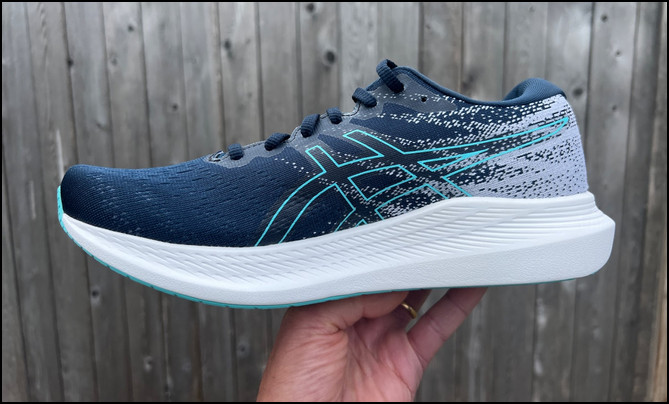
However, for midfoot and forefoot strikers seeking a smooth, efficient stride, the EvoRide can feel surprisingly supportive.
Overall, the stability of the Asics Cumulus 25 is better than the Evoride 3.
8. Size, Weight, & Fit
Size, weight, and fit are some of the basic aspects of a running shoe that affect how it feels on your foot and how it performs on different runs.
Here is a comparison of the Size, Weight, and Fit between the Asics Gel-Cumulus 25 and EvoRide 3 based on my personal experience:
| Aspect | Asics Gel-Cumulus 25 | Asics EvoRide 3 |
|---|---|---|
| Weight | 7.4 ounces (Men’s 9) | 9.3 ounces (Men’s 9) |
| Size | True to size | True to size (For wider feet sizing a half up is recommended) |
| Fit | Snuggly fit with roomier vibe | Narrow fit |
In terms of size, both models generally run true to size. In my experience, the Gel-Cumulus 25 offers a roomier toe box, providing ample space for toe splay while maintaining a standard fit around the heel.
Meanwhile, the EvoRide 3 has a slightly snugger fit overall, offering a secure and supportive feel throughout the foot.
When considering the weight, the EvoRide 3 is lighter. The weight difference might be noticeable for those who prefer a softer, more responsive shoe.
I liked the spacious toe box fit of the Cumulus 25. However, the Evoride 3 stands out with its lightweight construction. As each day passes, I gravitate more towards the Evoride 3 due to its remarkable weight advantage.
9. Price
Price-wise, the Cumulus and EvoRide 3 are close competitors. The Cumulus comes mid-budget at $140, while the EvoRide tips the scales at $120.
Honestly, both prices represent solid value for their respective strengths.
As a budget-conscious runner, I appreciate the affordability of the EvoRide, but the long-lasting comfort of the Cumulus was worth the extra $20.
The Asics Evoride 3 easily wins the price category as it comes at $120, cheaper than Gel-Cumulus 25. Also, it’s a solid shoe and value for money.
Pros and Cons between Asics Gel-Cumulus 25 and EvoRide 3
When selecting the perfect pair of running shoes, I understand how complex the task can be with the many options available.
However, by evaluating the advantages and disadvantages of different models, you can get a step ahead and pick the proper pair for your preference.
I already discussed the core differences between Cumulus 25 and EvoRide 3. Let’s check their strong points and weaknesses.
Asics Gel Cumulus 25
- »Cumulus has a comfortable and plush upper.
- »The integrated Gel unit in the heel and forefoot enhances overall cushioning.
- »Its 8 mm drop is better than Evoride for heel strikers.
- »Better for longer and more stable runs.
- »Compared to the Evoride, the Cumulus carries more weight.
- »Cumulus is pricer than Evoride.
Asics Evoride 3
- »EvoRide is lighter than Cumulus and better for speedwork and tempo runs.
- »The Guidesole and rocker design ensures an efficient and smooth ride.
- »Comes at $120, cheaper than Cumulus 25.
- »Breathable and supportive upper, provides a snuggly fit.
- »Compared to the Cumulus, the Evoride favors responsiveness over pure cushioning.
- »The curved sole can feel less stable than a flat one.
- »The absence of a Gel unit makes it less comfortable.
Personally, both shoes have their unique advantages. While Cumulus might be priced $20 higher, it offers advanced technologies in its midsole, making the price difference worth it.
Meanwhile, Evoride 3 encourages me to push my limit on the speed run.
ASICS Gel Cumulus 25 vs EvoRide 3: Which One is Better?
ASICS Gel Cumulus 25 stands out as a plush, maximalist daily trainer, offering optimum comfort for easy and recovery runs. Its complete revamp brings a softer, smoother, and more modern ride, ideal for long-distance endeavors.
On the other track, EvoRide 3 is a fantastic update to Asics’s smooth, versatile, uptempo daily trainer.
With an improved light and responsive ride, it caters to daily training and speedy uptempo efforts. Representing excellent value at an affordable $120, EvoRide 3 ensures runners get the most out of their investment, making it a budget-conscious runner’s dream.
Ultimately, if you crave plush comfort and stability for long, easy runs, the Gel-Cumulus 25 is ideal. But if you seek a lightweight, efficient ride with a touch of hidden speed, the EvoRide 3 will propel you forward.
FAQs
Who should buy the Asics EvoRide 3?
The Asics EvoRide 3 is designed to provide a lightweight and responsive running experience. It excels in speedwork and tempo runs, making it ideal for race training and runners looking to improve their performance.
What is the best all-around ASICS shoe?
The best all-around ASICS shoe is subjective. However, the Gel-Nimbus 25 and Gel-Kayano 30 are highly regarded for their cushioning, support, and versatility across various running distances.
Do podiatrists recommend ASICS?
Podiatrists frequently recommend ASICS footwear due to the brand’s commitment to providing excellent support and cushioning. As Miguel Cunha, a podiatrist and the founder of Gotham Footcare, suggested, Asics is a fantastic footwear option.
Who should buy the Asics Cumulus 25?
The Asics Cumulus 25 running shoe offers stability, durability, and a smooth ride for runners, particularly suited for prolonged, effortless runs. It is the 25th iteration of the popular Cumulus series, incorporating several key features to enhance comfort, support, and performance.

